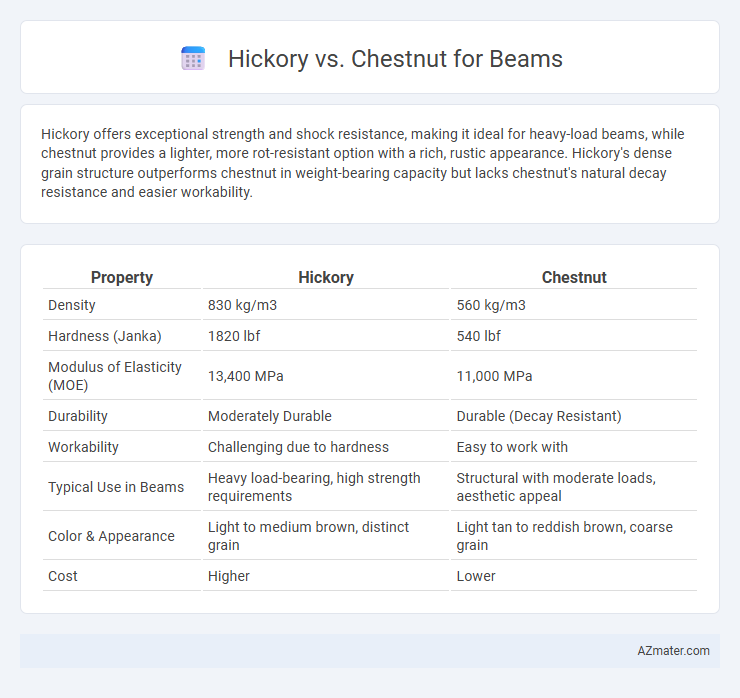Hickory offers exceptional strength and shock resistance, making it ideal for heavy-load beams, while chestnut provides a lighter, more rot-resistant option with a rich, rustic appearance. Hickory's dense grain structure outperforms chestnut in weight-bearing capacity but lacks chestnut's natural decay resistance and easier workability.
Table of Comparison
| Property | Hickory | Chestnut |
|---|---|---|
| Density | 830 kg/m3 | 560 kg/m3 |
| Hardness (Janka) | 1820 lbf | 540 lbf |
| Modulus of Elasticity (MOE) | 13,400 MPa | 11,000 MPa |
| Durability | Moderately Durable | Durable (Decay Resistant) |
| Workability | Challenging due to hardness | Easy to work with |
| Typical Use in Beams | Heavy load-bearing, high strength requirements | Structural with moderate loads, aesthetic appeal |
| Color & Appearance | Light to medium brown, distinct grain | Light tan to reddish brown, coarse grain |
| Cost | Higher | Lower |
Introduction: Comparing Hickory and Chestnut for Beams
Hickory and chestnut are popular hardwood choices for beams due to their strength and durability in construction. Hickory offers exceptional hardness and resistance to impact, making it ideal for high-stress structural applications. Chestnut provides a lighter yet sturdy alternative, valued for its decay resistance and ease of working in beam fabrication.
Wood Characteristics: Hickory vs Chestnut
Hickory wood offers exceptional strength and shock resistance, making it ideal for beams requiring high durability and load-bearing capacity. Chestnut features a lighter weight and excellent rot resistance due to its natural tannins, providing longevity in outdoor or moisture-exposed applications. Both hardwoods possess good workability, but hickory's hardness surpasses chestnut, influencing the choice based on structural needs and environmental conditions.
Strength and Durability Analysis
Hickory beams exhibit exceptional strength with a Janka hardness rating of 1,820, making them one of the toughest hardwoods available and ideal for structural support under heavy loads. Chestnut, while less dense with a Janka hardness around 690, offers superior rot resistance and longevity due to its high tannin content, contributing to its durability in outdoor or damp environments. Choosing between Hickory and Chestnut for beams depends on the required balance between maximum load-bearing capacity and environmental durability.
Weight and Density Comparison
Hickory beams typically have a density ranging from 800 to 900 kg/m3, making them heavier and more robust compared to chestnut, which has a density between 560 and 650 kg/m3. The increased weight of hickory corresponds to its higher hardness and strength, offering superior load-bearing capacity ideal for structural applications. Chestnut's lighter weight provides easier handling and is suitable where moderate strength and lower mass are desired.
Workability and Ease of Installation
Hickory beams offer exceptional workability due to their shock resistance and flexibility, making them easier to shape and fasten during installation compared to the denser chestnut. Chestnut's straight grain and moderate hardness facilitate smooth cutting and nailing, but its historical scarcity and age-related variability can complicate uniform installation processes. Contractors prefer hickory for projects requiring durability and ease of handling, while chestnut is selected for aesthetic and traditional appeal despite slightly more challenging workability.
Resistance to Decay and Insects
Hickory offers moderate resistance to decay and insect damage, making it suitable for interior beams but less ideal for exposed outdoor applications. Chestnut is highly resistant to decay and insect infestations due to its natural tannin content, providing superior durability in beams exposed to harsh conditions. Choosing chestnut beams enhances longevity and reduces maintenance in environments prone to moisture and insect activity.
Aesthetic Appeal and Grain Patterns
Hickory beams showcase a striking aesthetic appeal with their rich, varied hues ranging from pale blonde to deep reddish-brown, featuring contrasting dark streaks that emphasize rugged, bold grain patterns. Chestnut beams present a more uniform, warm golden-brown color with a straight, fine grain that conveys a classic, elegant look ideal for refined interior designs. Both woods offer unique visual textures, but hickory's dramatic grain patterns provide a more rustic, dynamic appearance compared to chestnut's smooth, consistent grain structure.
Availability and Sourcing Challenges
Hickory beams offer greater availability due to widespread growth in North America, making sourcing easier and more cost-effective for construction projects. Chestnut beams face significant sourcing challenges since American chestnut populations were decimated by blight, leading to limited supplies primarily from reclaimed or specialty sources. The scarcity and higher expense of chestnut beams often impact project timelines and budgets compared to the more readily accessible hickory.
Cost Considerations for Hickory vs Chestnut Beams
Hickory beams generally offer a more cost-effective option compared to chestnut, with prices typically 20-30% lower due to Hickory's greater availability and faster growth rates. Chestnut beams, while pricier, provide superior durability and resistance to decay, which can reduce long-term maintenance expenses. Evaluating both initial costs and lifespan performance helps determine the optimal choice for construction budgets and project requirements.
Best Applications: Choosing the Right Wood for Your Project
Hickory offers exceptional strength and shock resistance, making it ideal for structural beams in heavy-use areas such as flooring joists and load-bearing supports. Chestnut, known for its lighter weight and natural rot resistance, excels in outdoor applications like pergolas and porch beams where durability and weather resistance are critical. Selecting hickory ensures maximum load capacity, while chestnut provides longevity in moisture-prone environments.

Infographic: Hickory vs Chestnut for Beams
 azmater.com
azmater.com